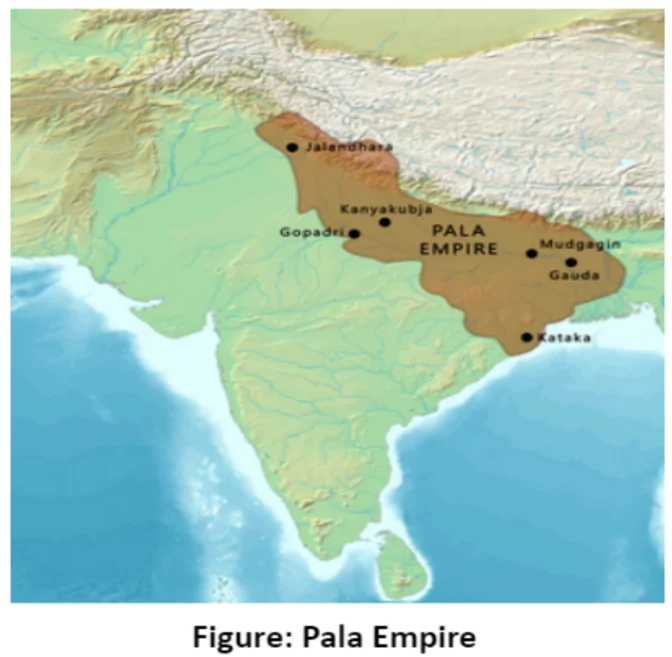Introduction
The Pala Empire, spanning from 750 to 1161 AD, emerged under Gopala and flourished as a prominent Buddhist dynasty in ancient India. With its capital in Bengal, the Palas extended their influence across Bihar, Orissa, Nepal, Assam, and even momentarily to Kannauj. Their reign marked a golden era of art, architecture, literature, and religious scholarship, leaving a lasting impact on Indian history.
Overview of the Rise and Fall of the Pala Empire:
1. Rise of the Pala Dynasty
- The Founding of the Pala Empire: The Pala Empire, was founded by Gopala (750–770 AD) and known as the “Kingdom of Dharma” by the Arabs.
- He founded a Buddhist Mahavihara at Odantapuri (Bihar).
 Dharmapala (780-810 AD): He assumed the titles Paramesvara, Parambhattaraka and Maharajadhiraja.
Dharmapala (780-810 AD): He assumed the titles Paramesvara, Parambhattaraka and Maharajadhiraja.
- Extent/Conquest: Khalimpur copper plate inscription mentions the extent of his kingdom covering Bengal, Bihar, parts of Orissa, Nepal, Assam, and momentarily, Kannauj.
- Kannauj Assembly: Dharmapala held a grand assembly at Kannauj to assert influence and consolidate his power over northern India.
- Architecture: Founded Vikaramashila monastery in Bhagalpur (Bihar)
- Vihara: Built a grand vihara at Somapura (Bangladesh)
- Religious Influence: He patronised Haribhadra, a Buddhist philosopher.
- Devapala (810–850 AD)
- Extent/Conquest: Son of Dharmapala, he extended Pala control eastwards up to Kamarupa (Assam). He defeated the Rashtrakuta ruler, Amoghavarsha.
- Religious Influence: He was also a great patron of Buddhism and granted five villages to Balaputradeva, the king of the Sailendra dynasty of Suvarnadipa (Sumatra), to maintain a monastery built by him at Nalanda.
- Other Rulers
- Mahipala I (988-1038 AD): was the son of Vigramapala II who checked the invasion of Rajendra Chola beyond the Ganges.
- Ramapala (1077–1120 AD): tried to recover the lost glory of the dynasty, but after his death, the presence of the Pala dynasty was confined to only a portion of Magadha (Bihar) and continued to exist only for a short period.
- Trade Relations with South-East Asia: Textiles, Pottery, and Rice were major items.
- South-east Bengal: was a hub connecting Arab trading settlements to the Malaya peninsula and Indonesian archipelago from the 7th to 11th centuries.
Enroll now for UPSC Online Course
C. Decline of the Pala Dynasty
- Dynastic Decline: The slide of the Pala dynasty was accelerated during the rule of Rajyapala, Gopala III and Vigramapala II.
- External Pressures: The rise of the Pratiharas in Jalore under Mihira Bhoja and the advance of the Rashtrakutas into Pala territories inevitably brought about the decline of the Palas.
- The End of an Era: Vijayasena of the Sena dynasty expelled the last ruler, Madanapala (1130–1150 AD), from Bengal and established his dynastic rule.
Conclusion
The Pala Empire stands as a testament to the flourishing of Buddhism and cultural exchange during ancient India. Despite its eventual decline, the Palas left behind a rich legacy of artistic marvels, educational institutions like Nalanda and Vikramashila, and a profound influence on religion and philosophy. Their contributions continue to resonate through the ages, reflecting a vibrant period of intellectual and spiritual growth in South Asia.
![]() May 14, 2024
May 14, 2024
![]() 4630
4630
![]() 0
0
 Dharmapala (780-810 AD): He assumed the titles Paramesvara, Parambhattaraka and Maharajadhiraja.
Dharmapala (780-810 AD): He assumed the titles Paramesvara, Parambhattaraka and Maharajadhiraja.